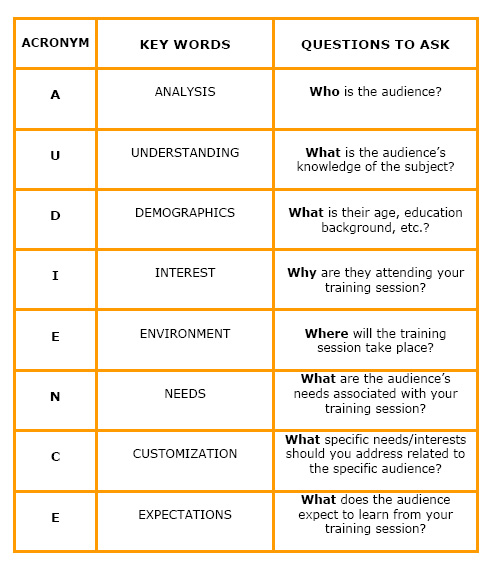Difference between revisions of "Audience Analysis"
From Learning and training wiki
| (65 intermediate revisions by 5 users not shown) | |||
| Line 1: | Line 1: | ||
| − | {{Term|AUDIENCE ANALYSIS| | + | {{Term|AUDIENCE ANALYSIS| A task or a tool which is generally the first step in setting a training activity. Training activities are targeted toward an intended audience, which should be defined by a number of factors such as learner's personal characteristics, intellectual and technology skills, [[Knowledge|knowledge]] level and purpose of learning. Conducting an audience analysis helps to identify the profile of the intended audience and their [[Learning Styles|learning style]] facilitating the design of the learning strategy that best suits its needs. <ref> [http://www.wikipedia.org Wikipedia] (5 March 2008) [http://www.fgcu.edu www.fgcu.edu] (27 june 2008), [http://www.wsu.edu www.wsu.edu] (27 june 2008)</ref> |
| + | |||
| + | |||
| + | See also: [[Needs Assessment]]; [[Stakeholder Analysis]]; [[Problem Tree Analysis]]; [[Focus Groups]]}} | ||
| + | |||
{{Tool|Conducting an Audience Analysis| | {{Tool|Conducting an Audience Analysis| | ||
__NOTOC__ | __NOTOC__ | ||
| − | ==''' | + | =='''Guidelines'''== |
| − | + | Conducting an audience analysis requires the identification of specific characteristics related to demographics, interests, knowledge, learning needs, and learning expectations - the who, what, where and why one can find in the [[#Audience Analysis Model|audience analysis model]]. | |
| − | + | ||
| − | *'''Define the audience | + | To prepare an audience analysis: |
| − | *''' | + | |
| − | *''' | + | *'''Define the background of the audience''' determining the social situation (who) and the subject knowledge level (what). |
| − | + | *'''Identify characteristics of the audience''' considering demographics (who and what), interests, needs, and expectations. | |
| + | *'''Consider the environment''' that is surrounding the audience (where).<ref> [http://www.wikihow.com www.wikihow.com] (8 October 2008), [http://www.ehow.com www.ehow.com] (28 August 2008) </ref> | ||
| + | |||
| + | |||
| + | =='''Audience Analysis Model'''== | ||
| + | |||
| − | + | [[Image:Audience_Analysis_Model.jpg|center]] }} | |
| − | ==''' | + | =='''Job Aid'''== |
| − | + | [[Image:pdf.png]] [[Media:Audience_Analysis.pdf|Conducting an Audience Analysis]] | |
| + | [[Image:word.png]] [[Media:Audience_Analysis_Template.doc|Audience Analysis Template]] | ||
| + | {{Addlink| | ||
| + | Below you will find articles on why audience analysis is critical:}} | ||
| + | {|border=1; width= 100% | ||
| + | !Link | ||
| + | !Content | ||
| + | |- | ||
| + | |[http://theelearningcoach.com/elearning_design/analysis-for-elearning-projects/ Analysis For eLearning Projects] | ||
| + | |An article outlining different forms of analysis- ranging from audience to technical analysis- that can be used prior to launching an e-Learning initiative. | ||
| + | |- | ||
| + | |[http://road-to-learning.blogspot.com/2009/05/more-about-audience-analysis.html More about Audience Analysis] | ||
| + | |This article reiterates the need for audience analysis to develop user-focussed courses. | ||
| + | |- | ||
| + | |[http://blog.integratedlearningservices.com/2010/06/amazon-would-make-good-instructional.html Amazon would make a good Instructional Designer] | ||
| + | |Through the example of Amazon’s approach to target products to its customers, this article explains the importance of understanding one’s audience when developing learning initiatives. | ||
| + | |} | ||
== References == | == References == | ||
<references/> | <references/> | ||
Latest revision as of 11:09, 3 October 2013
| A task or a tool which is generally the first step in setting a training activity. Training activities are targeted toward an intended audience, which should be defined by a number of factors such as learner's personal characteristics, intellectual and technology skills, knowledge level and purpose of learning. Conducting an audience analysis helps to identify the profile of the intended audience and their learning style facilitating the design of the learning strategy that best suits its needs. [1]
|
GuidelinesConducting an audience analysis requires the identification of specific characteristics related to demographics, interests, knowledge, learning needs, and learning expectations - the who, what, where and why one can find in the audience analysis model. To prepare an audience analysis:
Audience Analysis Model |
Job Aid
![]() Conducting an Audience Analysis
Conducting an Audience Analysis
| Below you will find articles on why audience analysis is critical: |
| Link | Content |
|---|---|
| Analysis For eLearning Projects | An article outlining different forms of analysis- ranging from audience to technical analysis- that can be used prior to launching an e-Learning initiative. |
| More about Audience Analysis | This article reiterates the need for audience analysis to develop user-focussed courses. |
| Amazon would make a good Instructional Designer | Through the example of Amazon’s approach to target products to its customers, this article explains the importance of understanding one’s audience when developing learning initiatives. |
References
- ↑ Wikipedia (5 March 2008) www.fgcu.edu (27 june 2008), www.wsu.edu (27 june 2008)
- ↑ www.wikihow.com (8 October 2008), www.ehow.com (28 August 2008)
